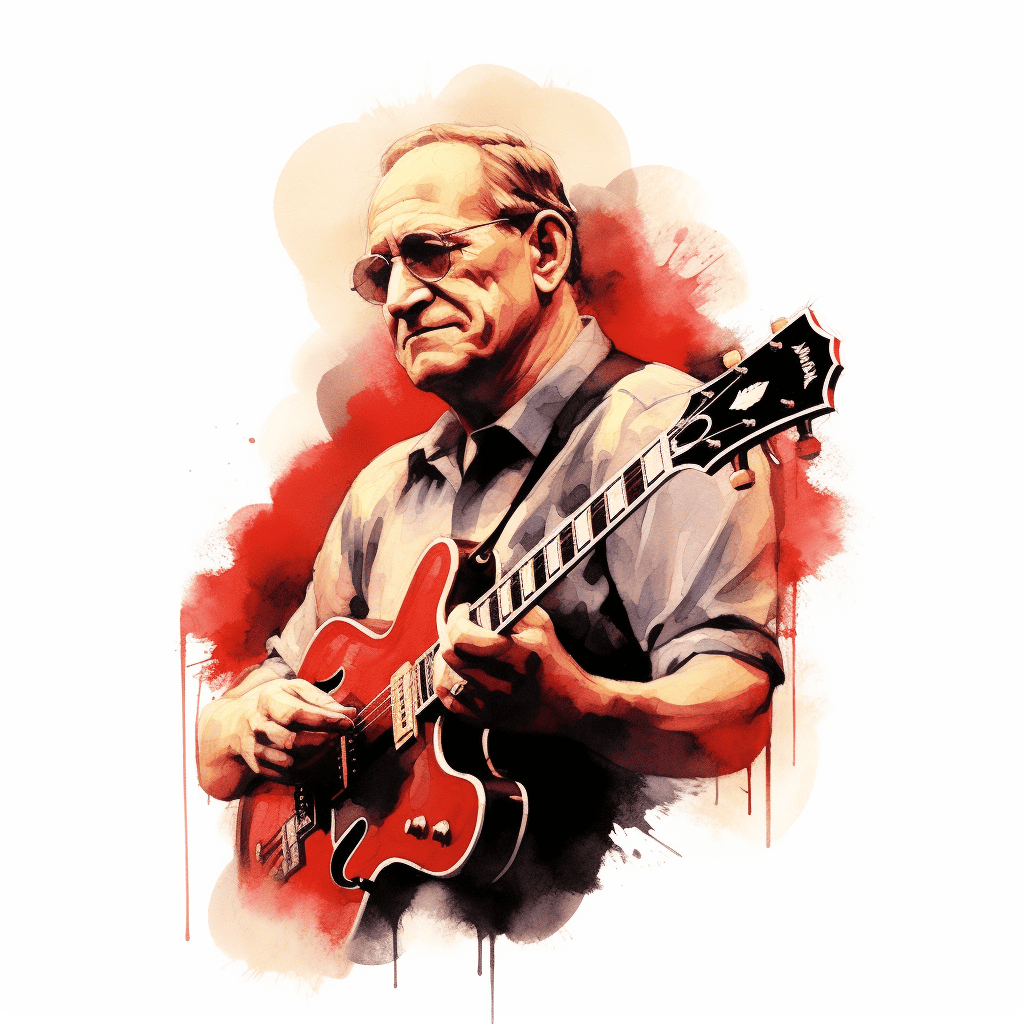You’ve probably found yourself mindlessly strumming away at your beloved six-string, and a question suddenly pops into your head, “Who on earth created this magical instrument?” or more specifically, “who created the guitar?” It’s quite a rabbit hole, my friend, and together, we’re about to dive in. The guitar, as we know it today, is the result of centuries of evolution. Early versions of stringed instruments can be traced back thousands of years to various parts of the world. Ancient civilizations in Egypt, Persia, and Greece all had their own versions of stringed instruments, or as some may call them, “musical instruments”, and you can bet they weren’t jamming out to ‘Stairway to Heaven’ on those! The most direct ancestor of the modern guitar, though, is the European lute, an instrument popular during the Middle Ages. The lute underwent several modifications over centuries, eventually resulting in the Renaissance-era vihuela – an instrument with six double strings, a lot like the twelve-string guitar we know today.
The Birth of the Modern Acoustic Guitar: Meet Antonio de Torres Jurado
Hold on to your picks, folks! It’s time to meet the man commonly recognized as the creator of the modern classical guitar – Antonio de Torres Jurado. This Spanish musician and luthier (that’s fancy speak for a person who builds or repairs stringed instruments) revolutionized guitar design in the mid-19th century. Before Jurado, guitars were a bit smaller, with less projection and fewer frets. Jurado, being the visionary that he was, decided to experiment with the body shape and size of the instrument. He increased the body depth and broadened the waist, thus giving the guitar a larger resonating chamber. This led to a significant improvement in the volume, tone, and projection of the instrument. It also gave the modern acoustic guitar the hourglass shape we know today.
The Electric Revolution: The First Electric Guitar and Mr. Les Paul

Enter Les Paul, the man who brought electricity into our beloved instrument and invented the electric guitar. Paul was an American jazz, country, and blues guitarist. He was always on the lookout for a way to make his guitar louder. And in the early 20th century, he found his solution with the help of electricity. Paul designed one of the first solid-body electric guitars in 1941. This revolutionary instrument was named “The Log” – not the most creative name, I agree, but it was pretty literal. It was essentially a 4×4 piece of pine with a bridge, a pickup, and a neck attached to it. Sounds simple, right? Well, it sparked the evolution of electric musical instruments and the music industry as a whole.
“The Log” was a game-changer. Its solid body helped to amplify the sound without causing feedback, a common issue with hollow-bodied electric guitars of the time. This solid body guitar design led to the creation of the Gibson Les Paul, one of the most iconic and first complete electric guitars in music history.
Now, I know what you’re thinking, “What about the bass guitar?” Well, my friend, patience is a virtue, and good things come to those who wait.
The Birth of the Bass: Standing on the Shoulders of Giants

Before we dive into the birth of the first solid body guitar for bass, let’s take a moment to appreciate the unsung hero of any band – the bassist. These musicians often get overshadowed by their pop star bandmates. But let’s face it, without the bass, your favorite songs would be as empty as concert halls during Covid.
Now, let’s give a big round of applause to Paul Tutmarc. Who’s that, you ask? Well, this Seattle-based musician and inventor gave birth to the first electric bass guitar, the Audiovox Model 736 Electronic Bass Fiddle, in the 1930s. This instrument was designed to be played horizontally – a significant departure from the upright double bass commonly used in orchestras and jazz ensembles.
However, it was Leo Fender who made the electric bass truly accessible and popular. In 1951, Fender introduced the Precision Bass, the first mass-produced and widely distributed electric bass guitar. Its design mirrored that of the Telecaster, one of Fender’s electric guitar models, marking a seismic shift in the design and playability of bass guitars.
Acoustic Wonders: Shaping the Sounds of Generations
Now that we’ve dived into the roots of our beloved guitar and appreciated the sparks of electrifying genius, let’s take a detour back to the unplugged world. Ah yes, the sweet, soul-stirring sound of the modern acoustic guitar – as beautiful and timeless as the smell of old books or a Friday when that clock strikes 5 o’clock.
The modern day acoustic guitar, as we play today, truly came to life thanks to a 20th-century American guitar manufacturer, C.F. Martin & Company. They introduced the dreadnought style of guitar – named after the formidable British battleships of the early 20th century, and boy, did it make waves. The dreadnought was bigger and bolder, both in size and sound quality. It quickly became popular among musicians of all musical genres.
Martin’s dreadnought guitars set the standard for modern acoustic guitars. They brought about a more balanced tone, a bigger sound, and a distinctive shape that has been replicated by guitar manufacturers worldwide. So, the next time you strum your acoustic, take a moment to appreciate the history in your hands.
Guitar Strings: The Melodious Evolution

From the resonating chords of Martin’s dreadnought guitars, we’ve witnessed the evolution of the acoustic guitar. It’s now time to take a look at the history of one of the most important aspects of any guitar, the guitar strings.
You’d be taken aback by the fascinating and untamed journey that brought us to the guitar strings we know and love today!
The String Theory: The Odyssey of Guitar Strings
If you’ve ever tried to untangle a set of guitar strings, you’d know it’s a bit like trying to reason with a toddler—challenging, and you’re not really sure how things got so chaotic in the first place. But have you ever wondered who we have to thank for this Herculean task?
The creation of guitar strings is a tangled saga that could unravel for pages. In the early days, strings were made from organic materials like gut (usually sheep intestines), silk, or even horsehair. Yes, you read that right—people used to pluck horsehair to craft these essential music tools. Gives a whole new meaning to ‘horsing around’, doesn’t it?
These days, of course, we’ve moved away from such rustic materials (much to the relief of sheep and horses everywhere). Modern strings, whether for your electric or acoustic guitar, are usually made of steel or nylon, thanks to Albert Augustine. He was a string maker who, in the 1940s, teamed up with renowned guitarist Andrés Segovia to develop the first nylon guitar strings.
When Innovation Meets Creativity: The Evolution of Bass Guitar Strings
Wait! We’re not done with strings yet. Bass guitar strings deserve a shoutout of their own. These are typically steel or nickel-plated steel wound, and boy, they are THICK.
It was James How, a British string maker and founder of Rotosound Strings, who gave the world a fresh take on bass guitar strings. In the swinging 1960s, he introduced roundwound bass strings, which were brighter and punchier than the flatwound strings commonly used at that time. These strings quickly gained popularity and were favored by famous bassists like John Entwistle of The Who and Geddy Lee of Rush.
Today, bassists have a veritable buffet of string options available, from flatwound for a smooth, mellow sound, to roundwound for that bright, assertive tone. Remember, folks, it’s all about that bass!
The Silent Heroes: Paying Homage to Unsung Innovators
While the journey of the guitar has seen big names grabbing the limelight, the symphony of guitar evolution wouldn’t be complete without the contributions of the unsung heroes. These were the visionaries whose passion for the craft propelled the instrument forward. It’s time to shed some light on these folks, shall we?
Lloyd Loar: The Maestro of Stringed Instruments
One of the most influential yet lesser-known pioneers of guitar design is Lloyd Loar. An engineer for the Gibson company in the early 20th century, Loar was a master luthier and acoustical engineer. He’s the brain behind the “f-hole” design in guitars, an innovation inspired by the world of violins. This feature, appearing as two stylized ‘f’ shapes on the body of the guitar, enhances the instrument’s resonance and projection. Loar’s designs have lived on in Gibson models and have become a distinctive trait of many stringed instruments today.
Fred Gretsch: The Stalwart Problem-Solver
The journey of the guitar saw numerous challenges, one of them being the issue of warping and cracking of the guitar bodies. A resolution to this predicament was presented by Fred Gretsch, a descendant of the Gretsch musical instrument lineage. His innovative approach was the introduction of laminated tops for guitars. This process, which involved the strategic layering of thin wood sheets in alternating grain directions, drastically improved the durability of guitars and reduced warping. This innovative yet economical solution enhanced the longevity of guitars and made them more financially accessible.
Seth Lover: The Pioneer of Noiseless Sound
The journey towards noiseless and improved sound quality was spearheaded by Seth Lover. A name that resonates synonymously with the humbucker pickup, Lover was an engineer for Gibson during the mid-1950s. He took up the challenge of eliminating the persistent ‘hum’ or interference that the single-coil pickups were infamous for. Lover’s solution was a redesigned pickup with two coils rather than one, wired to ‘buck the hum’, hence coined the ‘humbucker’. This ingenious invention drastically changed the soundscape of electric guitars by enabling them to be played at higher volumes without the intrusion of unwanted noise.
The legacy of these unsung innovators lives on in every pluck, strum, and riff. They’re proof that behind every great instrument, there’s a chorus of great minds, continuously fine-tuning the melody of progress. So, here’s to all those backstage heroes who’ve shaped the guitar’s journey – one innovation at a time.
Modern Guitar Innovations: The Unceasing Journey

The dawn of the 21st century marked the commencement of a new era of innovation in the realm of guitars. With advancements in technology and the introduction of new playing techniques, the evolution of the guitar continues, shaping the musical landscapes of contemporary times.
Self-Tuning Guitars: The Convenience of the Modern Age
In our fast-paced world, tuning a guitar can be a time-consuming task. This need for efficiency led to the birth of the self-tuning guitar. Tronical, a German company, unveiled the TronicalTune, the first-ever self-tuning system for guitars. This innovative product offered the convenience of tuning a guitar within seconds, giving musicians more time to focus on their creativity. Brands like Gibson quickly incorporated these systems, making the ‘perfect tune’ easily attainable. While traditionalists may frown upon this concept, the influence and convenience of self-tuning guitars in the modern age are undeniable.
Guitar Synthesizers: Fusing Analog and Digital
As we entered the digital age, the boundary between analog and digital instruments began to blur. The guitar was no exception. With the advent of guitar synthesizers, guitarists could now produce a myriad of sounds traditionally associated with keyboards. By converting string vibrations into MIDI signals, these devices allowed the guitar to mimic other instruments. This allowed for the creation of ambient soundscapes, and even trigger lighting effects. Renowned brands like Roland and Boss have been at the forefront of this innovation, offering guitarists a new universe of sonic possibilities.
The Silent Guitar: Practice Makes Perfect, Silently!
Then there’s the silent guitar, an intriguing development that caters to the modern urban lifestyle. Brands like Yamaha have developed ‘silent guitars’, which produce very little sound acoustically but can be heard clearly when plugged into an amplifier or headphones. This design allows guitarists to practice without disturbing others, making it ideal for late-night jam sessions or apartment living. With their foldable and compact design, silent guitars are also perfect for the travelling musician.
The past few decades have witnessed a surge in innovation, transforming the humble guitar into a formidable powerhouse of sound. These modern developments are reshaping the way we interact with guitars, opening up new horizons for musicians worldwide. As we continue to push the boundaries of what’s possible, one thing’s for sure: the evolution of the guitar is far from over.
Conclusion
In the grand symphony of history, the guitar stands out as a truly versatile instrument, capable of capturing the human spirit like no other. From its humble origins in the ancient civilizations of the East to the cutting-edge innovations of the 21st century, the story of the guitar is as diverse and dynamic as the music it produces.
As we delve deeper into the journey of who created the guitar, we can’t help but marvel at the transformative power of human creativity. It serves as a beautiful reminder that music, much like history, is a never-ending journey of discovery. Let’s keep strumming along to the rhythm of this fascinating journey, eager to see what the next chapter in the guitar’s story holds.
Frequently Asked Questions
1. Who is credited with the creation of the guitar?
While it’s difficult to pinpoint a single creator, the guitar as we know it has its origins in the ancient instruments of the East, evolving through various cultures and periods, with significant contributions from Spanish luthiers in the 19th century.
2. Who invented the electric guitar?
The electric guitar was introduced by George Beauchamp and Adolph Rickenbacker, who developed the “Frying Pan” in the early 1930s. However, it was Leo Fender and Les Paul who popularized it and revolutionized music with their designs in the 1950s.
3. Who was the mastermind behind the acoustic guitar?
The modern acoustic guitar, specifically the classical variant, owes its design to Antonio de Torres Jurado, a Spanish luthier from the 19th century.
4. Who invented the bass guitar?
The electric bass guitar was developed by Leo Fender and his team in the 1950s, providing a more portable alternative to the double bass used in orchestras and jazz ensembles.
5. Were there any unsung innovators in the history of the guitar?
Absolutely! People like Paul Tutmarc, who developed an early electric bass, and the countless unnamed luthiers of ancient times, significantly contributed to the guitar’s development.
6. What are some modern innovations in guitar design?
Modern innovations include advancements in amplification, such as the invention of the solid-state amplifier. The use of alternative materials, ergonomic designs, and even digital and smart guitars represent the cutting edge of guitar technology.
